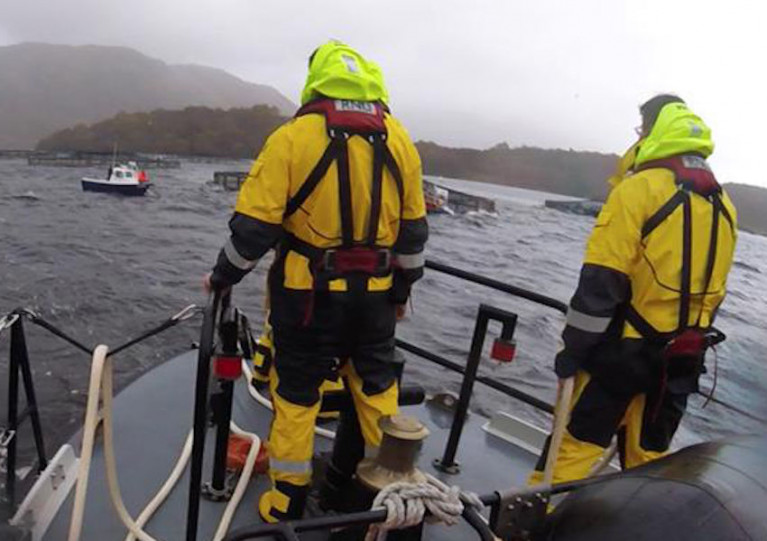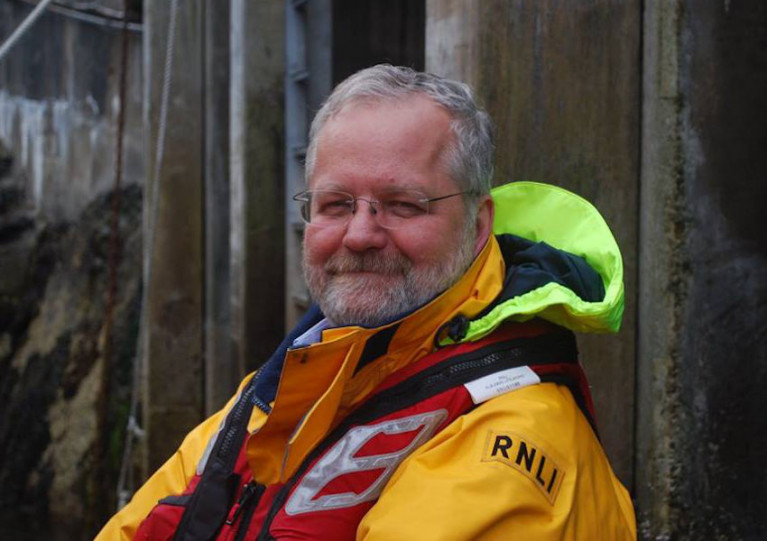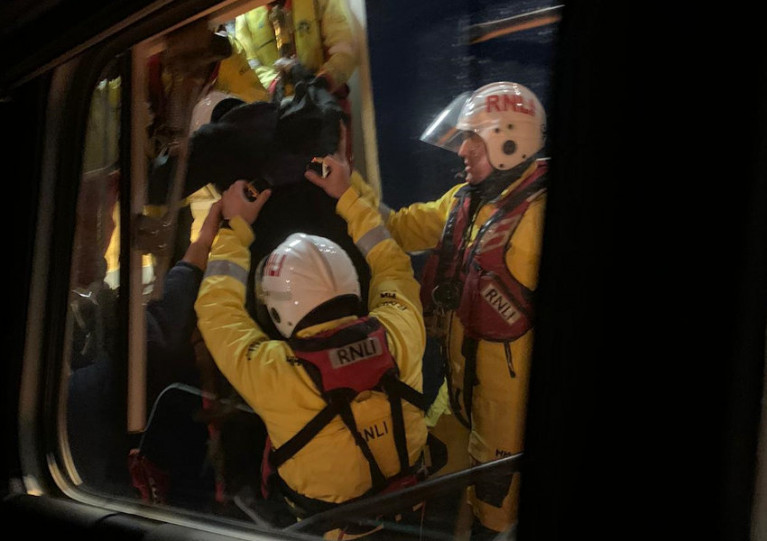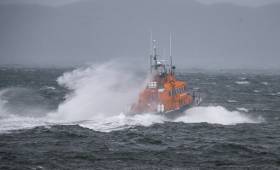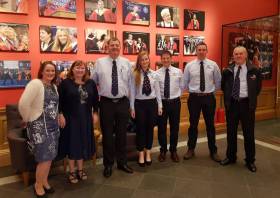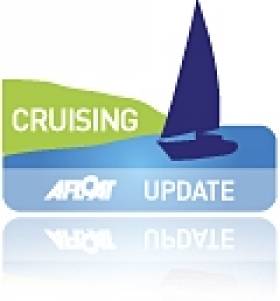Displaying items by tag: Oban
Yacht Sparks Launch of Oban Lifeboat in Strong Winds
Oban RNLI in Western Scotland launched to the aid of a yacht that has dragged its anchor in strong northerly winds on Friday afternoon (23 May).
The 30ft yacht with two people on board had run aground in the popular anchorage of Puilladobhrain, at the north end of Seil island.
As the all-weather lifeboat Mora Edith MacDonald made best speed towards the anchorage, however, the volunteers learned that the yacht had managed to refloat itself and its crew repositioned their anchor.
Oban RNLI reports that all were safe on board and no damage was sustained, but both persons were shaken from the experience — and with winds gusting 35mph, it was decided best to escort the yacht back to Oban.
Arriving on scene 30 minutes after launch, a lifeboat crew member was transferred onboard the yacht to assist. Their anchor was lifted but the gusty wind meant that they didn’t have time to stow it properly.
The yacht battled the strong winds and made way under their own engine as the lifeboat led them out of the anchorage.
Winds had picked up at sea and presented challenging conditions for the 30ft yacht as they proceeded back towards Oban.
Once in some relative shelter, the crew member onboard the yacht was able to stow the anchor, preventing it from damaging the yacht’s hull.
Arriving back in Oban by 6pm, another crew member was put onboard to assist with securing alongside and the yacht was safely berthed at the North Pier Pontoons shortly after with the assistance of Oban’s Coastguard Rescue Team.
Oban Lifeboat Assists Fishing Vessel in Storm Aiden
As Storm Aiden brought its gale-force winds and driving rain from Ireland to western Scotland, Oban RNLI launched to assist a fishing vessel in distress in Loch Etive.
The 22ft fishing boat, with four on board, had broken down west of Airds Point and managed to secure to a fish farm mooring while they awaited assistance yesterday afternoon, Saturday 31 October.
Meanwhile, the lifeboat launched amid heavy seas and 60mph gusts and reached the scene within half an hour to set up a tow to Taynulit pier, from where the fishermen had set out earlier in the day.
On arrival, however, the pier was submerged by the extremely high tide, and with no other shelter in the area it was decided to secure the fishing vessel to a mooring in Airds Bay and bring its crew ashore at Dunstaffnage with the lifeboat.
Oban RNLI coxswain Ally Cerexhe said: “Although the lochs may appear to provide some shelter, the strong winds and high tides still pose the same risk.”
Oban RNLI in western Scotland has expressed sadness at the retirement of Dr Colin Wilson as a volunteer crew member.
Dr Wilson has served the RNLI in Oban since 1990, first joining when the station had the Brede class lifeboat Ann Ritchie.
It was a love of the sea that drew Dr Wilson to sign up with the lifesaving charity. “I wanted to help those in distress,” he said.
Since joining, Dr Wilson has become a dedicated crew member and an integral part of the station’s family, contributing to many callouts, training exercises and fundraising events.
Over his 30 years with the volunteer crew, Dr Wilson attended a whopping 660 callouts totalling over 1,100 hours at sea, covering 12,668 miles — half-way around the world — and burning 159,891 litres of fuel. And that’s not including exercises and delivery trips.
His knowledge and expertise in both diving medicine and treating divers with decompression sickness has proved invaluable over the years
Dr Wilson’s 35 years as a local GP and time as a senior partner of the Lorn Medical Centre have seen his voluntary role extend further within the RNLI, as has contributed as a Lifeboat Medical Adviser and Regional Medical Adviser for Scotland as well as serving on the charity’s medical committee.
His knowledge and expertise in both diving medicine and treating divers with decompression sickness has proved invaluable over the years.
Finlo Cottier, a deputy coxswain and crew member of Oban lifeboat who has served alongside Dr Wilson since 2001, said: “It’s always reassuring when you go to sea with Colin amongst the crew. A special blend of knowledge, wisdom and humour.”
Another longtime cremate, Ian Henry, said: “Colin has been an absolute stalwart and aside from being a mentor, font of knowledge, medical advisor both formal and informal, medicinal coffee prescriber, he has first and foremost been a friend. I know I speak for everyone when I say the door is always open.”
Of the hundreds of callouts he attended, the one that sticks out most for Dr Wilson was just two years ago, on the night of 28 July 2018.
“It was a really nasty night with winds gusting 60 knots and we received three separate Mayday calls,” he said. “It was a great crew all working together for good results in adverse weather.”
Another was on 10 January 1998, as documented in Willie Melville’s book The Story of Oban Lifeboat:
One of those services that brings tremendous satisfaction to a coxswain, his crew and the whole station took place on 10 January. Oban Coastguard reported that a canoeist was overdue at Cuil Bay, Duror…
The lifeboat arrived on scene at 1952, first making a counter-clockwise search of the island. As she was veering offshore to avoid the shallows her searchlight picked up the canoeist clinging to the waterlogged canoe some 2 cables offshore.
Crew member Dr Colin Wilson assessed the casualty's condition as being serious enough to have him airlifted by the rescue helicopter, also on scene, to hospital in Oban - meantime he was given oxygen on the lifeboat and made as warm as possible.
Dr Wilson recalled: “This man was extremely hypothermic and was lucky to be found alive. He survived, and was discharged home the next day. A great result.”
When asked what he will miss most, Dr Wilson said: “I will miss working as part of a really great crew and team. I have shared in both the joy of many successes and in the sadness surrounding some less happy events, providing care and support wherever possible.
“I hope to continue my association with Oban Lifeboat by volunteering in a different capacity.”
Dr Wilson also passed on his thanks to fellow crew members, “past and present, for great memories of working in a fantastic team, in training, in fundraising and ultimately, while out at sea on shouts”.
He added: “I also salute all those who support the RNLI throughout the country in the many ways they do, helping those in trouble at sea.”
Oban Lifeboat Launches Into Storm Ciara
The volunteer crew of Oban RNLI’s lifeboat Mora Edith MacDonald faced the gale-force conditions of Storm Ciara on two separate callouts yesterday (Sunday 8 February).
At 10:14am, HM Coastguard requested an immediate launch following reports of a group of divers in difficulty to the south of Oban, in Western Scotland.
Despite challenging conditions the lifeboat reached the scene quickly, but found that the divers had already been recovered from the water.
The lifeboats small inflatable XP boat was made ready to put a crew ashore to assist with casualty care. However, the Scottish Ambulance Service and coastguard rescue teams arrived at that point and were able to assist the casualties.
At this time, further reports reached the coastguard of another diver drifting to the north. The lifeboat immediately proceeded to the scene and discovered that the object was actually the dive gear of one of the divers now being treated by the Scottish Ambulance Service.
After the crew returned to station and as they were drying off, one of the volunteers noticed a dingy drifting across Oban Bay.
It was observed that the oars were in place on the dinghy, which prompted concern that someone may have fallen from it, so the crew relaunched into Storm Ciara to ensure that no life was at risk.
Several boats were on moorings in Oban Bay and a systematic search of these moorings began. Oban Coastguard Team, who had also just returned from the previous incident located the dinghy and were able to identify a name on it.
Fortunately this allowed them to locate the owner, who was safe and well and unaware that his dinghy had gone adrift.
Busy Start To New Year For Aberdeen & Oban Lifeboats
It’s been a busy start to the New Year with multiple callouts for Scottish RNLI lifeboat crews at Aberdeen on the east coast and Oban in the west.
Aberdeen’s all-weather lifeboat was called for a medevac from an oilfield platform supply vessel (PSV) at anchor in Aberdeen Bay on Friday evening (3 January).
The casualty complained of chest pain and numbness in one side of his body – symptoms typically associated with heart attack — and the lifeboat launched immediately, navigating through an unusually busy bay anchorage.
Coxswain Michael Cowlam said: “Conditions were excellent — perfect visibility and a gentle swell from the gentle offshore breeze. The challenge was finding the right vessel in the densely crowded anchorage. None of us had ever seen it so busy.”
Once the casualty’s vessel had been located, however, he was swiftly returned to shore and the care of the Scottish Ambulance Service.
Less than 24 hours previously, Aberdeen’s D-class inshore lifeboat and the all-weather vessel’s Y-boat were launched to assist in a river bank search of the River Dee after concerns were raised for the safety of an elderly man missing in the area.
The crews searched extensively but were stood down when, happily, a member of the public found the missing man in the city centre.
Lifeboat operations manager Bill Deans later commented: “For all three of Aberdeen’s lifeboats to be called out on service in the first three days of a New Year is exceptional. I can’t remember a start to the year like it in my 40-plus years’ service at Aberdeen Lifeboat Station.”
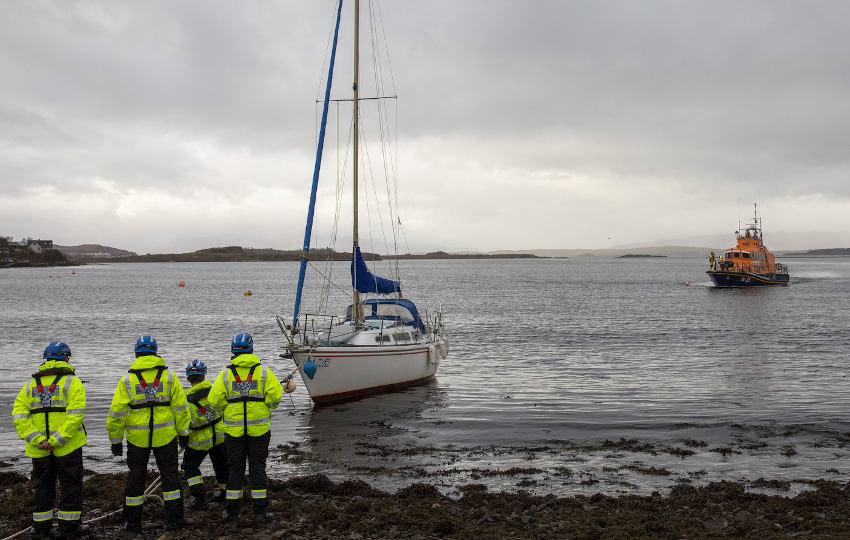
Elsewhere, in Oban, the lifeboat Mora Edith MacDonald was launched twice to two separate incidents between Friday and Saturday (3 & 4 January).
The first call came at 7.26pm on Friday following reports of a red flare sighting in Loch Melfort. A thorough search was conducted by the lifeboat, Oban’s coastguard team and HM Coastguard’s rescue helicopter but with nothing found, the search was stood down.
Just hours later, shortly before 10am on Saturday morning, the volunteers were called again, this time to a yacht that had broken its morning in Connel Bay and run aground.
Given the nature of the tides in the area, near the Falls of Lora, the decision was made to refloat the vessel, which has no persons on board at the time, and secure it to a nearby morning.
Two Callouts & 120 Miles Covered By Oban Lifeboat This Weekend
It was a busy weekend for Oban RNLI in Western Scotland, with its lifeboat Mora Edith MacDonald responding to two separate incidents, covering over 120 miles.
The first call came Saturday afternoon (7 December) as the lifeboat launched in gale force winds and high seas, alongside the Islay RNLI lifeboat, to assist a 28m vessel that had lost steering in the Sound of Jura, just north of the MacCormaig Islands.
Islay were first to arrive on scene and it was established that the casualty vessel was able to make way using its emergency steering. Oban lifeboat was requested to rendezvous with the Islay volunteers and the casualty vessel to take over the escort.
Having battled high seas and poor visibility, the Oban crew arrived on scene shortly after 6pm.
While the casualty vessel was able to make way under its own power, the decision was made to continue escorting it to the safety of Craobh Haven Marina.
Given the weather conditions, with wind speeds of up to 50mph and the size of the vessel, it was decided that the Islay lifeboat should also remain on scene. The vessel made a steady speed north towards Craobh accompanied by both lifeboats.
On arrival at 8.15pm, the Oban lifeboat used its searchlights to illuminate the entrance in driving rain, giving the casualty vessel enough visibility to manoeuvre into the marina.
After several attempts at berthing in extremely challenging conditions, the vessel made it alongside with assistance from the Oban crew and, with the help of Craobh Haven Marina’s staff, the vessel was safely tied alongside by 9pm.
The second call came yesterday afternoon (Sunday 8 December) when the volunteer crew launched at 3pm to a report of a yacht adrift off Corpach.
The lifeboat made best speed in the conditions, arriving on scene by 4.30pm. Two crew members were put on board the yacht to determine whether anyone was on board.
With nothing found, it was decided a line would be put ashore to a nearby pier to ensure it didn’t drift further. The Fort William Coastguard Team were also on scene to take lines ashore and secure the vessel.
Prestigious Awards For Volunteering Go To Scottish Lifeboat Stations
Volunteers at Oban and Tobermory’s RNLI lifeboat stations in eastern Scotland have been recognised for their invaluable service in this year’s Excellence in Volunteering Awards.
Oban’s four deputy coxswains — Mark Scott, Finlo Cottier, David Isaac and James Hardie — have all been recognised by the RNLI for their dedication to the station.
The certificates awarded by the RNLI’s chairman and council recorded their “sincere thanks” for “giving time to help provide full time coxswain cover at the station” and for their “commitment and leadership”.
In addition, the Argyll station’s press officers Iain Fulton and Leonie Mead also received awards for their “invaluable support to Oban Lifeboat Station”.
Meanwhile, Tobermory Lifeboat Station — nearby, on the Isle of Mull — received an Excellence in Volunteering Award earlier in the autumn following an operational evaluation carried out by an independent RNLI team of assessors.
The award recognised the crew’s “invaluable service to the institution” and that “with a committed management team and crew fully engaged in all aspects of the station, your focused team efforts, camaraderie and professionalism are greatly appreciated”.
Tobermory lifeboat operations manager Dr Sam Jones also received an award in recognition of her “invaluable service” to the station, of her “outstanding contribution” and for “making a positive impact at the station, engaging the crew and providing safe and effective leadership”.
Full-time coxswain David McHaffie and mechanic Paul Gunn have also received staff awards in recognition of their leadership and dedication at the station.
The RNLI’s prestigious Excellence in Volunteering Awards recognise both staff and volunteers who have gone above and beyond what is expected of them.
Members of both stations attended a celebratory dinner at the Playfair Library in Edinburgh on Saturday 16 November, hosted by the RNLI’s chairman Stuart Popham and Scottish chairman Roger Lockwood.

The dinner rounded off a busy week for Tobermory RNLI. Members of the crew represented the station at the previous weekend’s Remembrance events in Tobermory, including the community commemoration, ‘Mull Remembers’, on Saturday 9 November and Sunday’s service at Tobermory Parish Church and wreath-laying at the war memorial.
Tobermory’s RNLI shop and fundraising branc,h along with some members of the crew, also hosted a mince pie and coffee morning at the Aros Hall on Saturday 16 November. This well-attended annual event took over £600 in shop sales and an incredible £508 from a raffle and donations.
McHaffie said: “The awards to the station recognise the hard work of everyone involved, particularly our volunteers who give up so much of their free time, not only for training and carrying out rescues, but also for helping to make the station run effectively and efficiently.
“I’m pleased that some partners of the crew were also able to attend the celebratory dinner in Edinburgh as we couldn’t operate without the support of our families and friends.”
Oban Marina Gets Ready for Busy Season
It's not part of the necklace of marinas around the Irish coastline but at just 150 miles from Carlingford, Oban Marina in Scotland is one of the closest to it. The modern marina is based on the picturesque Isle of Kerrera and it is the gateway for many Irish boats heading for the Scottish West Coast.
This summer, Oban marina will welcome several new regattas with competitors from afar afield as Denmark.
Following expansion in 2010, the marina can now accommodate up to 145 visiting yachts on fully serviced pontoons and swinging moorings. Its marina and boatyard services, plus proximity to some of the most spectacular cruising and racing grounds in the world, has increased its attraction to regatta organisers world wide.
This year Marina Manager, Sue Deacon and her team, will welcome several new high profile events with yachtsmen from overseas as well as those closer to home:
"We have already played host to competitors taking part in the Sebago Round Britain and Ireland Challenge and Scottish Peaks Race," says Sue Deacon. "Next month (July), we are looking forward to welcoming a very special visitor - the ex-Royal yacht, Bloodhound, who will use Oban Marina as her base for several weeks chartering this summer. World Cruising Club's Malts Cruise will also make Oban Marina their base before the start of this popular event and around 40 yachts will sail to Oban Marina from Denmark as part of the Danish Ocean Cruising Association's rally."
Organisers are happy to use the marina as a convenient stop-off point for their event and the facilities ashore include a restaurant, bar and use of a boatshed for larger functions. Charlie Walker, Managing Director of the Sebago Round Britain and Ireland Challenge explains: "We were delighted to bring the yachts into Oban and it was the perfect choice for the West Coast of Scotland stopover as Oban Marina has great facilities and all tides access."
Summer home port for Ex-Royal Yacht
With Royal wedding fever at its height, the marina is looking forward to its own royal visitor - Bloodhound, the fully restored classic 1930s yacht which once belonged to Her Majesty The Queen and His Royal Highness The Duke of Edinburgh. Bloodhound now belongs to the charitable trust that also owns and manages the five-star visitor attraction, The Royal Yacht Britannia in Edinburgh. She is normally on view to visitors throughout the year as the centrepiece of a new Royal Sailing Exhibition.
The legendary racing yacht will be available for charter out of Oban Marina this summer from 11 July until 24 August and up to 8 guests will be able to enjoy sailing through the stunning scenery of Scotland's West Coast, as well as the hospitality of the skipper and crew, who are all former HMY Britannia 'Royal Yachtsmen'.
Bob Downie, Chief Executive of The Royal Yacht Britannia is pleased to be bringing Bloodhound back to the West Coast and to Oban Marina: "We are delighted to be taking Bloodhound back to the waters on which she once sailed with the Royal Family. She is such an important part of British sailing history, and this really is a once in a lifetime opportunity to step back in time."
Malts Cruise
Up to 40 yachts taking part in World Cruising Club's Malts Cruise will be welcomed at Oban Marina for two days on 8/9th July and to mark the start of the event, a buffet supper and ceilidh will be held in the marina's 'Boatshed'. It is sure to be a memorable party, setting the tone for the remainder of the cruise. The start on Sunday 10th July will include a spectacular Parade of Sail as the fleet head off to their first stop in Tobermory. Yachts then select their own route to the next rendezvous in Port Ellen, allowing exploration of the islands and secluded anchorages of the West Coast. The event supported by Diageo's Classic Malts Selection, is not just about sailing though, as the Malts Cruise is a wonderful opportunity to experience traditional Scottish hospitality, local specialities like scallops and whisky, and to have a great time with fellow cruisers.
http://www.worldcruising.com/maltscruise/
Danish Rendezvous
The Danish Ocean Cruising Associations's Pennant will be flying high to welcome around 120 sailors in over 40 boats from Denmark. Weather permitting, the fleet should arrive at Oban Marina on 11th/12th July before heading off to enjoy the rest of their malts cruise. After staying for a few days to enjoy local hospitality and the marina facilities, Coordinator, Karsten Pennov said: "Everyone is very enthusiastic about the event and we are very much looking forward to staying at Oban Marina."
West Highland Yachting Week 29th July to 5th August.
Once again, Oban Marina will be hosting competitors in West Highland Yachting Week with a ceilidh, seafood grill and BBQ on Sunday 31st July overlooking Oban Bay. Boats will be at the marina from 31st July to 3rd August.
Classic Malts Selection Whiskies Add Flavour to Cruising Event
The Malts Cruise is a two week summer sailing voyage, combining exceptional cruising around the remote Hebridean waters, with a journey of discovery into the world of Scottish single malt whisky. A programme of cruising in company and solo exploration is mixed with social events ashore and rendezvous afloat.
The Malts Cruise starts in Oban, with rendezvous in Tobermory and Loch Tarbert Jura, before finishing in Port Ellen. Parties, crew dinners and a ceiledh are mixed with visits to distilleries, plus briefings on Scottish wildlife, history and culture take place along the route. Between rendezvous yachts can follow their own itinerary, exploring ashore and afloat, alone or in groups.
Any vessel can take part, as long as it's crewed by two or more people. The event will be popular with bareboat and skippered charterers, as well as boat owners from the British Isles, Scandinavia and northern Europe. For 2011, places are limited to 50 boats. To date 19 boats are entered, both power and sail ranging from 14.6m to 9.8m.
Malts Cruise Key Dates:
08 July 2011 - cruise office opens in Oban Marina, Kerrera
09 July 2011 - welcome party in Kerrera
10 July 2011 - parade of sail in Oban Bay
21 July 2011 - final party in Port Ellen
Malts Cruise Cost:
No boat fee. £225 per person. Children under 18 are free.
Quotes from participants of Classic Malts Cruise 2009:
"Doing the cruise gave the incentive to cruise further than my normal cruising area, so was able to enjoy and experience the area, scenery and the abundance of wildlife we saw (minke whales, porpoises, dolphins and sea eagles to mention just a few). Many thanks - certainly one of the 'must do' cruises." Eriska (GBR) Hallberg Rassy 312
"It was a great way to get my first taste of cruising in Scotland." Blue Fox (IRL) Oyster 461
The Malts Cruise website is available at www.worldcruising.com/maltscruise
2011 Afloat Almanac: If you're contemplating a cruise, short coastal passage or even just studying for a Nav course this season, don't forget the 2011 edition of the Afloat Irish almanac (with Reeds Data). It covers the whole of Ireland, the Scottish, English and Welsh West coasts. Buy it online. CLICK HERE Easy!



























